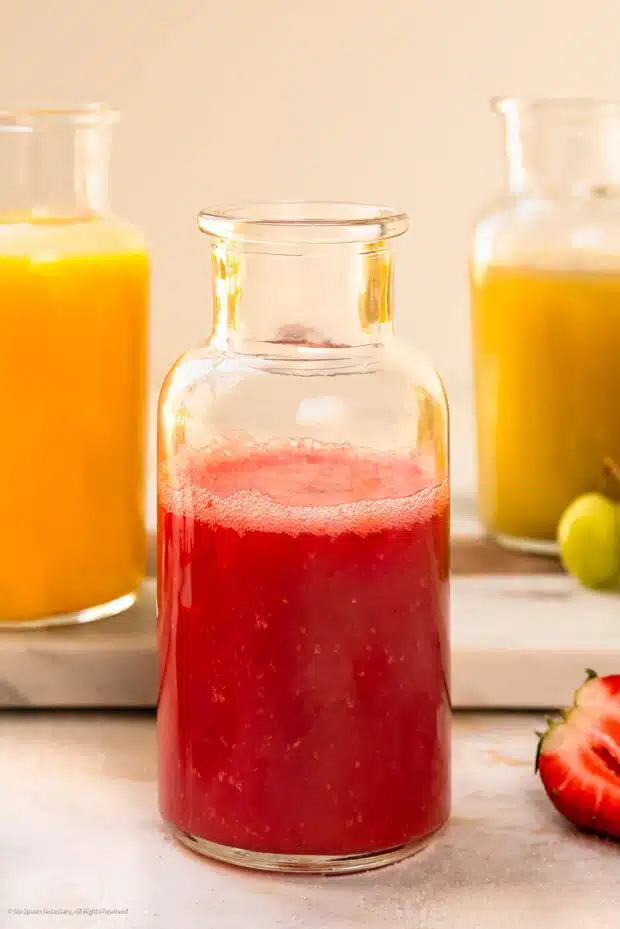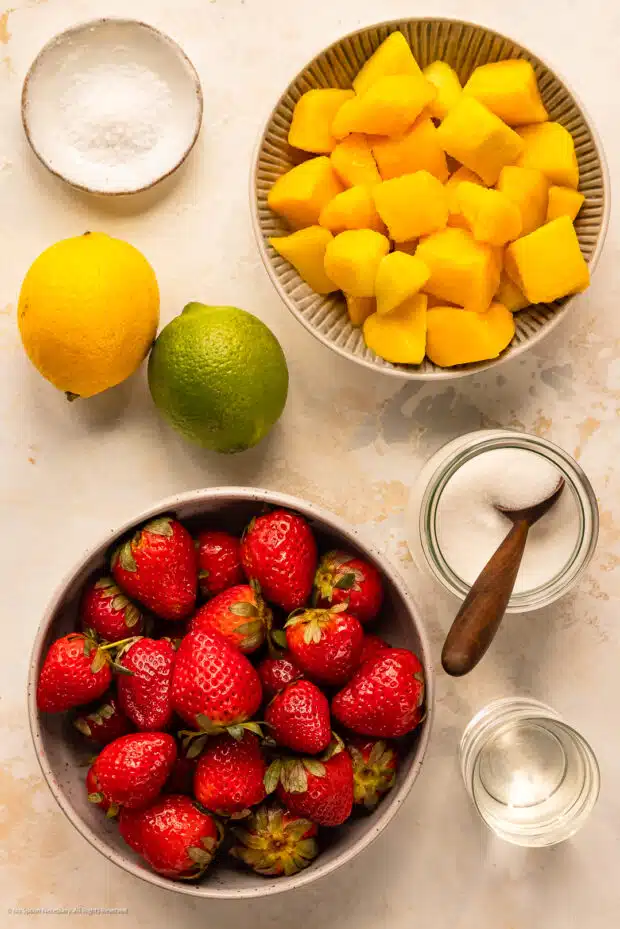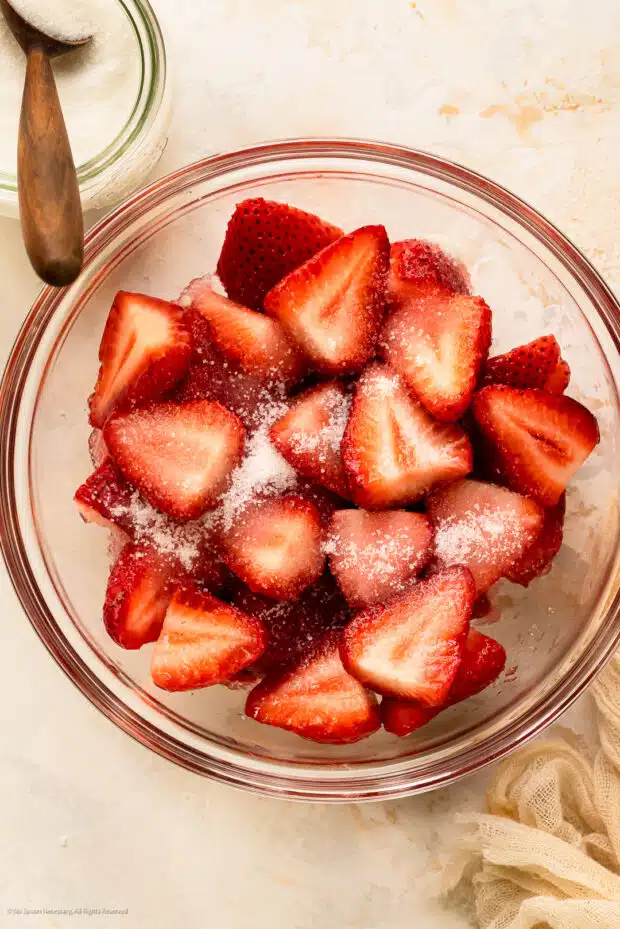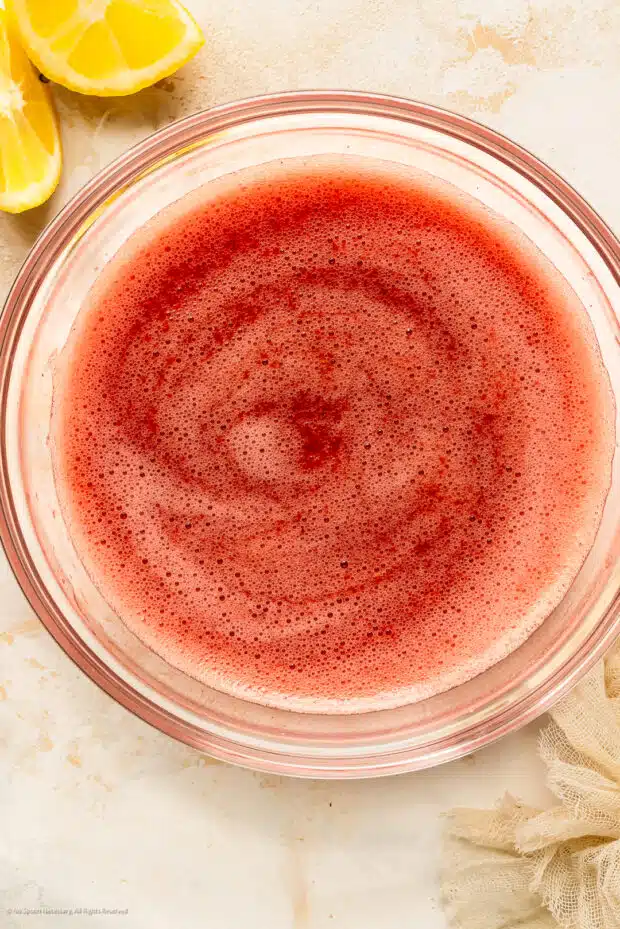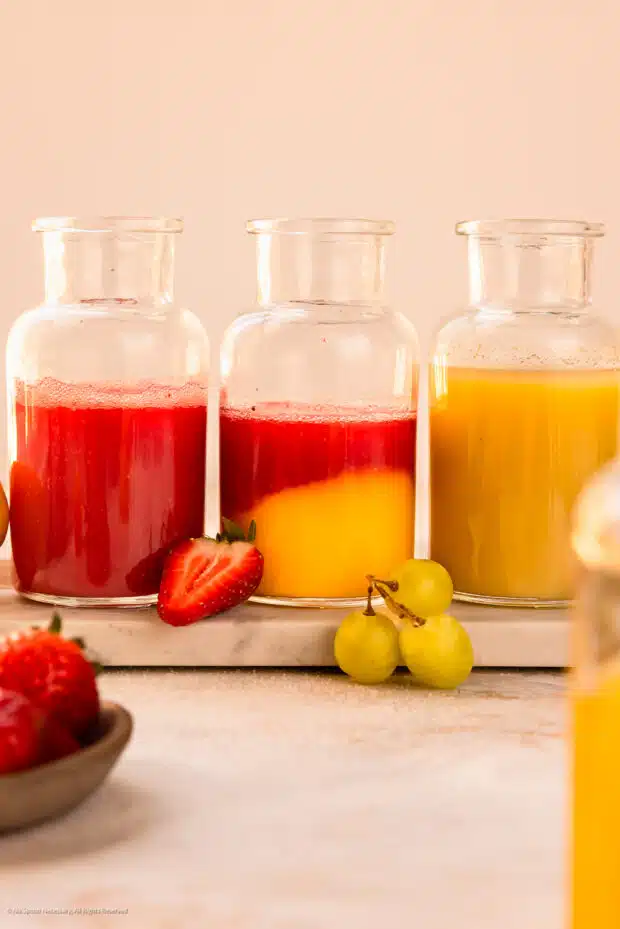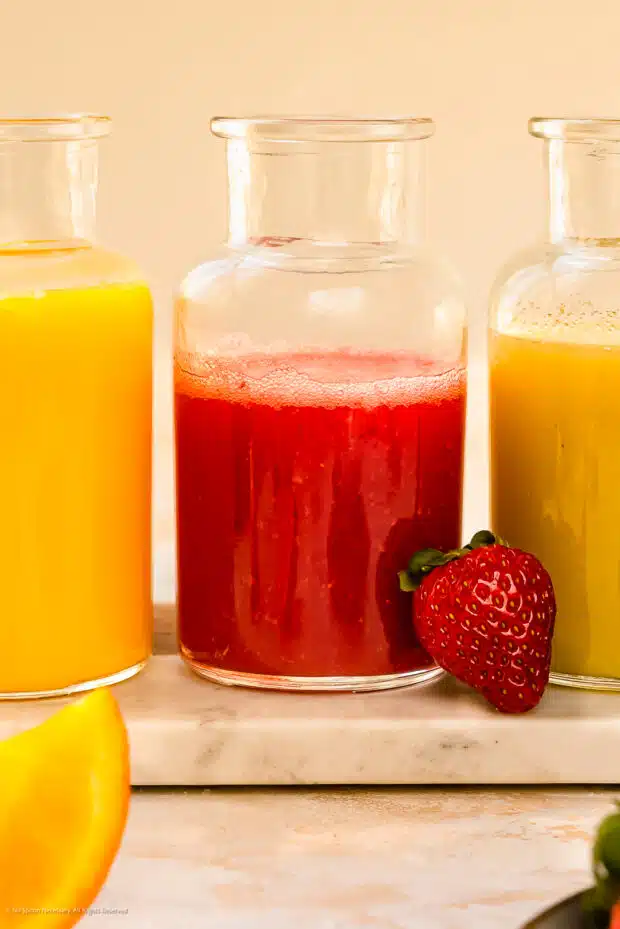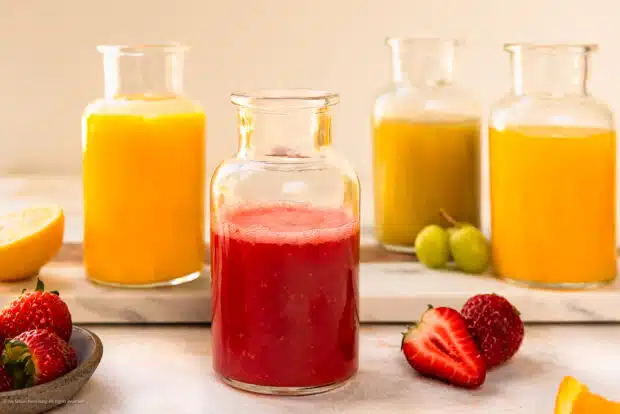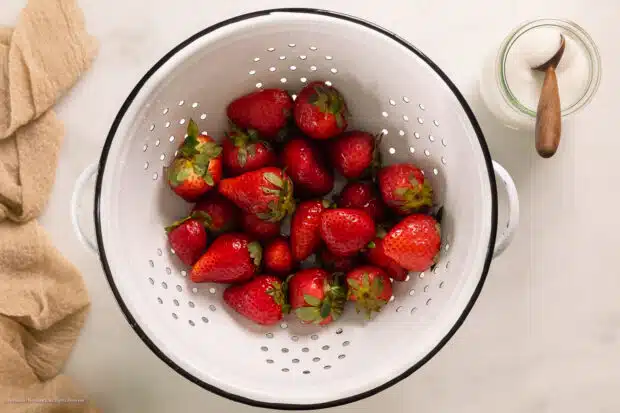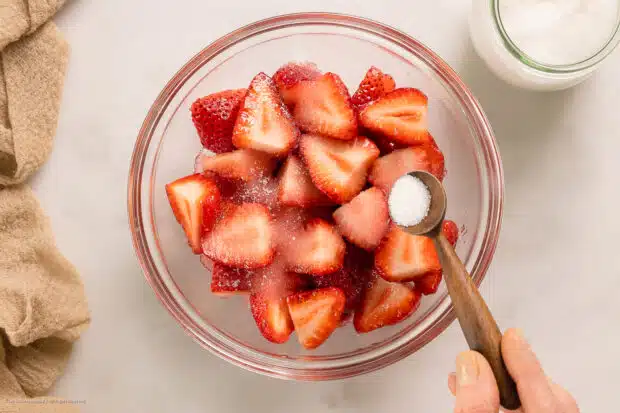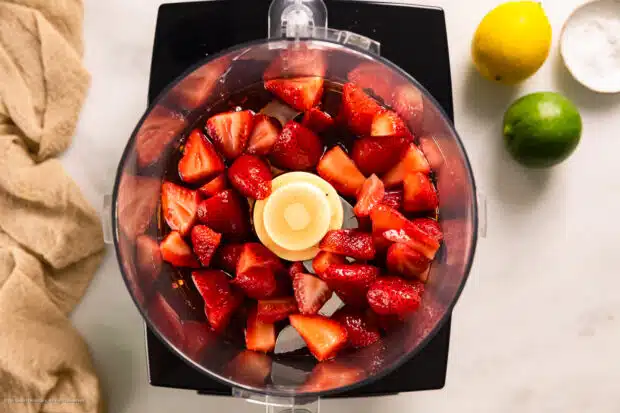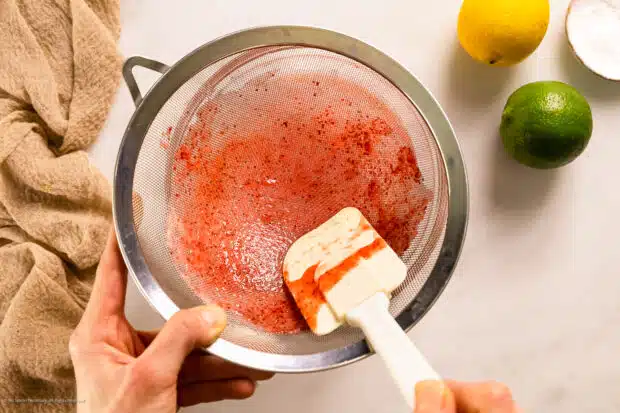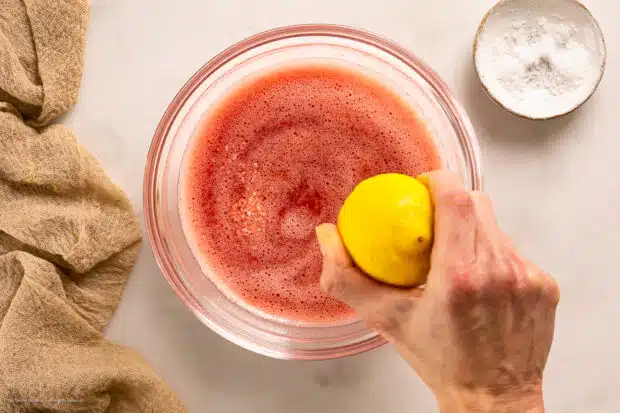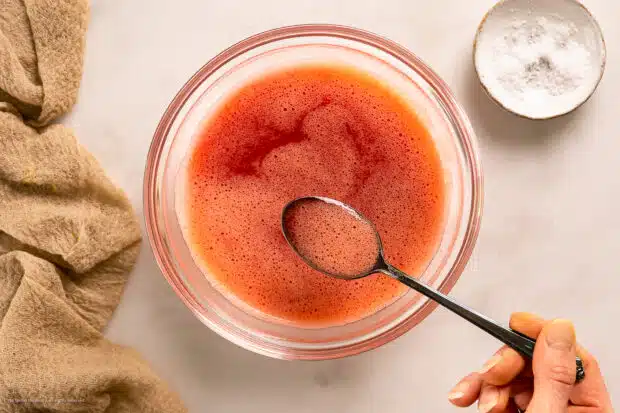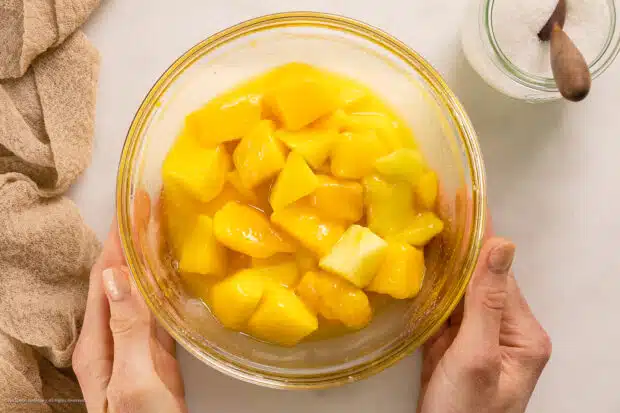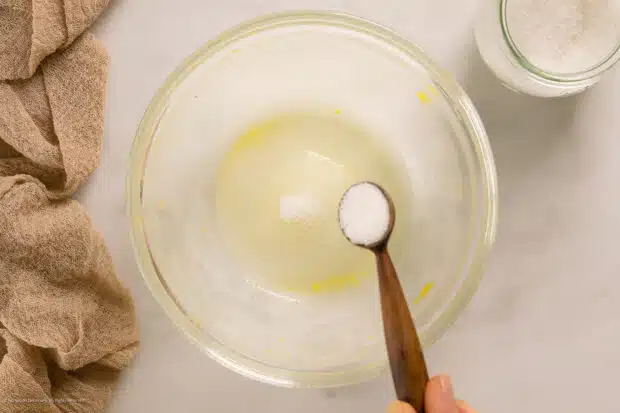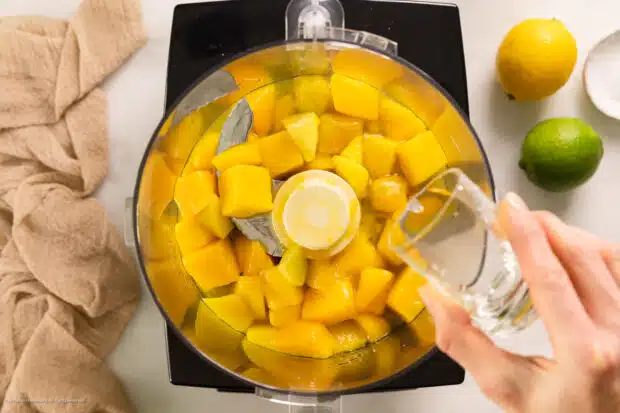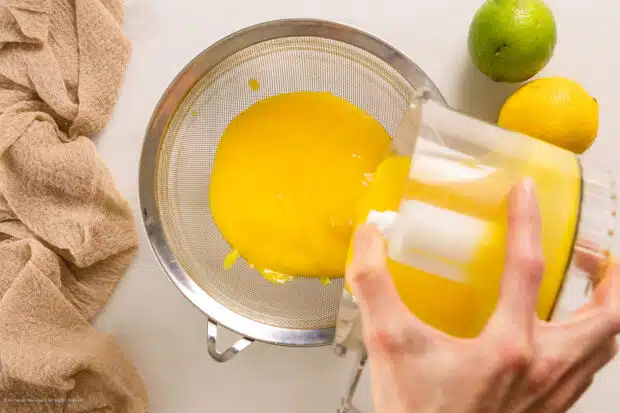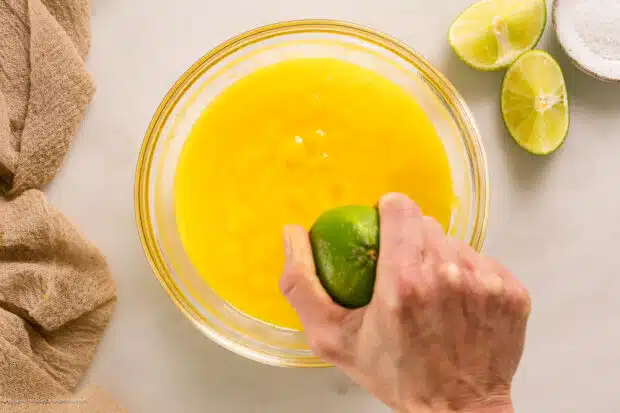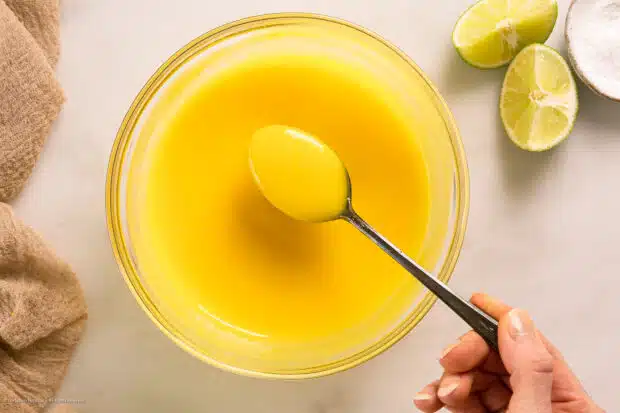This post may include affiliate links. Thank you for your support.
Get ready to embark on a delicious adventure as you discover the endless possibilities of Homemade Fruit Purées! With just a few simple ingredients, a blender or food processor, a few minutes of prep, and some creativity, you can create vibrant pureed fruit flavors that will take your culinary, drinks, and cocktails creations to the next level. (Recipe includes instructions for using both fresh and frozen fruits.)
Table of Contents
About this recipe for fruit purees
Looking to add some fruity pizzazz to your recipes? Pureeing your own fruit at home is the way to go! Not only is it a fun way to experiment with different flavor combos and preserve your seasonal CSA bounty, but it also allows you to control the sweetness and texture of your puree fruit to perfectly complement your dish. Plus, who doesn’t love a little DIY project in the kitchen?
So, why settle for store-bought fruit purees when you can easily make your own — with NO chemical additives, preservatives, or artificial anything? That’s what I thought. Besides, pureed fruit isn’t just for cocktails! You can use fruit puree for all drinks, such as smoothies, or use them in cakes, cupcakes, and more!
Why you’ll love this puree recipe!
Aside from being made with just a handful of pantry staples and your favorite variety of produce, these bright and beautiful fruit purées for drinks, desserts, and recipes galore are also:
- Quick & Easy – Aside from prepping the fruit by washing, pitting, and/or peeling it as needed, the whole process of making cocktail purees takes just 2-3 minutes using a blender or food processor.
- Endlessly Versatile – Whether you’re in a tropical mood and want a pineapple-mango-papaya mix, or are celebrating spring with strawberry-rhubarb purée, you can mix and match any of your favorite fruits into hundreds (or more!) permutations. I suggest blending the fruits separately when you start, then mixing a small “taster” to see if you like the combo before whisking together the entire batch of puree drinks.
- Budget-Friendly – Buying in-season produce or loading up on on-sale fresh or frozen veggies as they arise is a great way to keep your grocery budget in check. Processing the fruit into a purée has the added benefit of extending the shelf life of fresh produce because it’s also…
- Freezer-Friendly – These homemade cocktail purées are ideal for freezing for up to 6 months, meaning big, juicy flavor is never far from your fingertips.
Ingredient for fruit puree
You don’t need much to make a delicious fruit purée for cocktails and other recipes. Here’s what to grab:
- Fruit – Feel free to use any variety of ripe, fresh (or frozen) fruit you desire. If using frozen, allow it to defrost first to make it easier to blend into cocktail purees.
- Sugar – Use as needed, depending on how sweet your fruit is and what application you’re using it for.
- Substitutions: Swap in fresh cane juice (that’s what they use for real mojitos!) or other liquid sweeteners like honey, maple syrup, or agave. You can also use any variety of sugar you prefer, including brown sugar, jaggery, piloncillo, or muscovado sugar to make fruit puree for drinks.
- Lemon or Lime Juice – A touch of acidity helps to balance the flavors of your purée mix, plus helps to prevent oxidization. Fresh is best, but in a pinch, you can swap in bottled citrus juice instead.
- Substitutions: Consider using other acidic fruits like grapefruit or orange juice to puree fruit instead.
- Salt – A pinch of salt helps to wake up the flavor of fruit and somehow makes it taste sweeter.
- Substitution: If you’re on a salt-free diet, consider using lemon or lime zest instead.
- Water – Add as needed to help the blades of your blender or processor tackle the fruit.
- Substitutions: You’re also welcome to try using fruit juice, but you may want to cut down on the added sugar if you do. Alternatively, use a high-water content additive like watermelon or cucumber to add more flavor while you blend.
Puree fruit flavors
There are approximately 1.8 bazillion different cocktail purée flavors to choose from, so mix and match to your heart’s content. These are some of the flavors that I’m most asked about for beverages, but please — don’t let this list be a limiting factor!
- Strawberry Puree
- Mango Puree
- Strawberry Mango Purée
- Raspberry Puree
- Peach Puree
- Passion Fruit Puree
- Banana Purée
- Mixed Berry Purée
- Kiwi Purée
- Grape Purée
- Cherry Purée
- Pineapple Purée
- Blueberry Puree
Dietary variations
Aside from which fruits to choose from, you can also edit this recipe for fruit puréed to fit your personal needs. Here are a few potential dietary variations to consider:
- Reduced Sugar or No Sugar Added – If you’re trying to cut back on your sugar intake, you can reduce the amount of sugar in the recipe or substitute it with a natural sweetener like honey, maple syrup, or brown rice syrup. You’re also welcome to use a sugar substitute like stevia or monkfruit, but be sure to adjust the amount added depending on the sweetness level of your preferred sweetener.
- Fruit & Vegetable Purée – Whether you’re making homemade baby food, want to add a savory touch to your recipe or want an added boost of nutrients, adding some veggies into the mix can be a great choice. For most vegetables (including squash and sweet potatoes) you’ll want to peel and cook the veggies first before adding them to the mix. Feel free to roast, blanch, steam, or sauté the vegetables depending on your preferred method of cooking.
- Roast Your Fruit – Cooking your fruit helps to concentrate the natural sugars and gives the purées a certain je ne sais quois.
- Make It Spicy – Add some heat with your choice of fresh chile peppers, chili powders, or even hot sauces like sriracha. Jalapeño raspberry margaritas FTW!
- Add Texture & Crunch – Consider adding chia seeds, flax seeds, or oats to your fruit purees recipe depending on what you plan on using them for. These nutrient-dense additions are great for smoothie bases or baby food.
What’s your favorite iteration of fruit puree for drinks? What about for desserts? Or savory recipes? Let me know in the comments below so I can cheer you (and your genius creations) on!
Best fruits for pureeing
You can use any fresh or frozen fruits to make cocktails puree at home. However, the prep work directly depends upon the fruit(s) you select. See below:
Fresh fruit purees
- Soft Fruits: Wash and remove the stems of any soft fruits, such as berries and melon before chopping.
- Grapes – Use seedless grapes and wash the fruit prior.
- Berries – Wash and remove stems. Cut any large fresh strawberries in half.
- Watermelon – Use a chef’s knife to cut the flesh from the skin. Then, use your fingers to remove all the seeds (beans). Note: You do NOT need to add water when using watermelon to make puree!
- Stone Fruits: Wash the fruit. Then boil to peel and remove the skin. Finally, remove and discard the pits.
- Peaches – Use frozen slices to make life easy. Or for fresh, wash the peach and then score the skin. Boil to soften the skin and then peel the skin from the flesh. Use a sharp knife to cut the flesh off the pit.
- Mango – Use frozen chunks to make life easy. Or for fresh, hold the mango upright and with a small paring knife, carefully slice half of the mango from the pit, keeping your knife towards the center of the mango. Turn the mango 180-degrees and repeat. Next, use your knife to make crosshatch or grid-like lines through the mango flesh, being careful NOT to cut through the skin. Push on the mango skin to invert it and pop-up the little cubes of mango flesh. Then, use your knife to carefully slice the mango cubes from the skin.
- Cherries – Wash the fruit before removing and discarding all the pits
- Pome Fruits: If using fruits with a “core”, such as an apple or pear, wash the fruit before peeling and discarding the flesh. Finally, remove and discard the tough core before chopping.
- Apples – Wash the fruit, then use a vegetable peeler to remove the skin. Next, use a sharp knife to cut the apple’s flesh from the core. Then, chop the apple into large chunks.
- Pineapples – Use frozen chunks to make life easy. Or if you prefer fresh, use a sharp Chef’s knife to remove the outer rind from the pineapple. Then, cut the pineapple from the inner core. Finally, chop the fruit.
Frozen Fruit puree
If you want to make real fruit purees with as little prep work as possible, I can’t recommend frozen fruit enough! It’s picked at peak ripeness, washed, prepped, and frozen within 24 hours, so the quality is amazing. Just make sure you defrost the fruit prior to using it to make fruit purees for drinks.
How to make fruit purée for drinks, desserts, and more!
Once you select your fruit(s) – fresh or frozen – you’re ready to blitz them into a silky smooth, flavorful liquid puree drink. The process is slightly different if you’re using frozen fruit (see the printable recipe card below), but here’s how to puree fruit:
Making this recipe for fruit purees
- Wash and Chop Fresh Fruit: Wash, peel and pit the fruit before roughly chopping into large chunks if you need. Also, if your fruit has a peel and pit, such as a peach, you’ll need to boil and remove the skin before pitting and chopping. Or to make your life easier, just use frozen fruit to make pureed fruit recipes.
- Macerate Fruit: Add the chopped fruit to a bowl. Sprinkle the sugar over the fresh fruit and then use a spoon to stir and coat the fruit. Set aside and let the fruit macerate for at least 20 minutes on the counter, or cover and store in the fridge up to overnight.
- Blend Fruit with Water: Add the chopped fruit and the water mixture to a high-speed blender. Cover and blend the fruit for 2-3 minutes, or until a thick, smooth sauce forms. Stop to scrape down the bowl with a rubber spatula as needed.
- Strain the Puree: Place a sieve or fine-mesh strainer over a bowl. Pour the pureed fruit into the strainer and use a rubber spatula to press the puree through the strainer, discarding the seeds, pulp, and any solids.
- Add Flavor: To the bowl with the fruit puree, add in the lemon or lime juice and salt. Stir well to combine. Taste the cocktails puree and adjust as necessary – adding more sugar for sweetness, citrus juice for acidity, salt for overall flavor, and/or water to thin it out.
- Refrigerate: Cover the bowl or transfer the puree to a pitcher and store in the refrigerator for up to 2 weeks. Or use the fruit puree for drinks recipes and homemade cocktails.
Expert tips for the best fruit pureed
- Secret to Keeping Berries Fresher For Longer: Fill a large bowl with 4-parts cold water (4 cups) to 1-part white vinegar (1 cup). Add berries to a colander and place the colander into the bowl, making sure all the berries are submerged. Place the bowl in the fridge for approximately 20 minutes. Remove from the fridge and lift the colander out of the bowl. Rinse the berries well with cold water and pat dry.
- Use ripe fruit. While you can certainly purée fruits that are on their last leg to extend their useful life, you’ll get the best flavor from fruits that are in their prime.
- Store the puréed fruit in zip-top bags to make a “library” of fruit in your freezer. We have book libraries and music libraries, so why not make a FLAVOR library? To do this, divvy up your cocktail fruit purée in labeled and dated freezer-safe zip-top bags, press out as much air as possible, and freeze them flat. Once frozen, store them upright so you can easily grab a bag like you would a book from a shelf.
- Consider straining them. If you’re using something with a lot of seeds (say, strawberries or raspberries), use a mesh strainer to fish all the seeds out for a smoother purée and a seedless smile.
- A high-powered blender or food processor will give you the smoothest and most consistent purée. If you don’t have one, you can still make cocktails puree with a food mill, regular blender, or immersion blender. However, it may take a bit longer to get the desired consistency of your fruit puree for drinks.
Using purees in cocktails
You can utilize fruit purees to make colorful drinks, cocktails, and mocktails with fresh fruit.
- Fruit Mocktail – Add fruit puree to a rocks glass, top it off with club soda, and garnish with a slice of fresh fruit for a refreshing beverage.
- Martini Mocktail – Use your favorite flavor of pureed fruit and top it off with sparkling grape juice. Serve in a traditional martini glass for a delicious alcohol drink.
- Fruit Mojito – Add rum, lime juice, and your favorite puree of fruit to a cocktail shaker. Shake, pour into a glass, top off with club soda, and garnish with mint leaves.
- Sparkling Wine Mimosa – Pour an ounce of fruit pureed into a champagne flute and top with prosecco.
FAQs: puree for drinks
Are cocktail purées healthy?
“Healthy” is one of those words that means a lot of things to a lot of different people, and, TBH, I think it’s not a particularly useful metric because of its subjectivity. Rant over.
That said, I’m all for eating the rainbow and incorporating as many whole foods into my diet as possible. While there is a minimal amount of added sugar in these homemade purées, you’re welcome to omit it if you prefer. Either way, extra fruit seems like a nutritious choice to me!
What is a purée for cocktails made of?
While it depends on the brand or recipe, my version of fruit pureed is made with just a few simple ingredients: fruit plus salt, sugar, water, and lemon or lime juice as needed.
Is fruit puree made of real fruit?
While I can’t speak to the wide world of CPGs, this homemade cocktail fruit puree for drinks version is absolutely made with real, delicious, juicy fruit!
Serving cocktail purees
The great thing about homemade puréed fruit is that you can use it in dozens of fun ways, from drinks and cocktails, to smoothies and parfaits. Here are just a few ideas to get your creative wheels turning:
Purees for breakfast
- Drizzle your favorite fruit purée over pancakes or waffles for a burst of fruity flavor.
- Pair it with a warm, chocolate dipping sauce for your favorite breakfast baked goods, like cinnamon sugar donut muffins or mini powdered sugar donuts.
- Add a spoonful of purée to your yogurt cups, chia fruits, oatmeal, trifles, or any breakfast cup for a beautiful and flavorful swirl.
- Serve as a fruit juice with your favorite egg recipes, like breakfast muffin eggs, avocado eggs on toast, egg bagel in a hole, and sausage breakfast sasseroles.
Using purees in dinner recipes
- Perhaps surprisingly, fruit pureed can also be used as a sauce for savory dishes like meat or fish. For example, peach purée makes for a gorgeous glaze on grilled chicken or pork, and mango purée (preferably with some spicy chiles) is lovely on fish like shrimp.
And dessert
- Use fruit purée as a filling for cakes or cupcakes. You can also use it as a layer between fresh fruit cakes for a colorful and flavorful surprise.
- Mix in a spoonful of fruit purée into popsicle molds or use it as a topping for your favorite bowl of ice cream, like berries ice cream. Or for a healthier alternative, use it over frozen yogurt and parfait yogurt cups.
Fruit puree for drinks
- Use pureed fruit as a base for fruit flavored alcoholic drinks or mocktails. You can mix it with your favorite liquor, such as tequila, white rum, and vodka. Or even just add some sparkling water for a refreshing drink. Or play around with classic cocktails, such as the Mimosa cocktail by swapping out the orange juice for fresh fruit purees. Pureed fruit works great in other traditional cocktails, like a margarita and bellini.
- Add some fruity goodness to your milkshakes and smoothies for extra pizazz.
- Make fruit ice cubes to chill your drinks. As they melt, they’ll add color and flavor to whatever you’re sipping on!
Storing pureed fruit
Does fruit purée need to be refrigerated?
Yes, you should store your fruit purée in the refrigerator if you are not going to use it immediately. You can store a homemade fruit purée in an airtight container in the fridge for up to 5 days. However, if you want to store it for a longer period of time, you can freeze it in a freezer-safe container for up to 3-6 months.
Can you freeze fruit purée?
You sure can! In fact, I love keeping several different fruit cocktails puree in my freezer at all times. That way, I can use my fruit pure and whip up a tasty drink, cocktail, or cake filling at the drop of a hat.
Can you re-freeze fruit purée?
I do not recommend refreezing fruit purees once thawed. When you freeze and then thaw a food item, the process causes ice crystals to form and then melt. This process can alter the texture and flavor of the food. Refreezing can cause even more ice crystals to form, which can lead to a watery or mushy consistency.
I suggest dividing up the pureed fruit into smaller amounts for freezing so you can only defrost what you need. If storage bags are too large, consider using an ice tray!
How long does fruit purée last?
Freshly made fruit purée should last in an airtight container in the fridge for up to 5 days, or in the freezer for 3-6 months.
Alright, my fruity friends! I’ve had a berry good time chatting with you. Next time you’ve got a boatload of fruit on hand, I hope you’ll consider making something delicious (and nutritious!) fruit purée. Until next time, happy blending!
Chey
Craving MORE? Follow all the deliciousness on Facebook, Pinterest and Instagram!
More recipes using fruit!
- Strawberry French Toast
- Banana Popsicles with Fruit and Yogurt
- Berry Yogurt Parfait Cups
- Strawberry Shortcake Sundae
The best fruit puree recipe for drinks, cocktails, smoothies, and more!👇

Fruit Puree Recipe
Equipment
- 1 Fine-Mesh Strainer
- 1 Mixing Bowl
- 1 Food Processor
Ingredients
- 2 Cups Fruit - fresh or frozen (SEE NOTES)
- 2 TBS Granulated Sugar – or more to taste, depends upon the sweetness of your fruit (SEE NOTES)
- 2 TBS Water
- 1 ½ tsp Fresh Lemon or Lime Juice – or more to taste
Instructions
PUREE WITH FRESH FRUIT
- Wash and Chop Fresh Fruit: Wash, peel and pit the fruit before roughly chopping into large chunks as needed. If your fruit has a peel and pit, such as a peach, you’ll need to boil and remove the skin before pitting and chopping. (SEE NOTES for prepping fruits)
- Macerate Fruit: Add the chopped fruit to a bowl. Sprinkle the sugar over the fresh fruit and then use a spoon to stir and coat the fruit. Set aside and let the fruit macerate for at least 20 minutes on the counter, or cover and store in the fridge up to overnight.
- Blend Fruit with Water: Add the chopped fruit and the water to a high-speed blender. Cover and blend the fruit for 2-3 minutes, or until a thick, smooth sauce forms. Stop to scrape down the bowl with a rubber spatula as needed.
- Strain the Puree: Place a sieve or fine-mesh strainer over a bowl. Pour the fruit puree into the strainer and use a rubber spatula to press the puree through the strainer, discarding the seeds, pulp, and any solids.
- Add Flavor: To the bowl with the puree, add in the lemon or lime juice and salt. Stir well to combine. Taste the fruit puree and adjust as necessary – adding more sugar for sweetness, citrus juice for acidity, salt for overall flavor, and/or water to thin it out.
- Refrigerate or Use: Cover the bowl or transfer the puree to a pitcher and store in the refrigerator for up to 2 weeks, or until ready to use in cocktails and drink recipes.
FROZEN FRUIT PUREE
- Thaw Frozen Fruit: Add the frozen fruit chunks to a bowl and thaw according to package instructions. Use a slotted spoon to remove the fruit from the bowl and transfer to another bowl.
- Macerate Fruit: Add the granulated sugar to the thawed fruit liquid in the bowl. Whisk to combine. Then, add the thawed fruit back to the bowl and stir to combine. Set aside and let the fruit macerate for at least 20 minutes on the counter, or cover and store in the fridge up to overnight.
- Blend Fruit with Water: Add the chopped fruit and the water to a high-speed blender. Cover and blend the fruit for 2-3 minutes, or until a thick, smooth sauce forms. Stop to scrape down the bowl with a rubber spatula as needed.
- Strain the Puree: Place a sieve or fine-mesh strainer over a bowl. Pour the fruit puree into the strainer and use a rubber spatula to press the puree through the strainer, discarding the seeds, pulp, and any solids.
- Add Flavor: To the bowl with the puree, add in the lemon or lime juice and salt. Stir well to combine. Taste the fruit puree and adjust as necessary – adding more sugar for sweetness, citrus juice for acidity, salt for overall flavor, and/or water to thin it out.
- Refrigerate or Use: Cover the bowl or transfer the puree to a pitcher and store in the refrigerator for up to 2 weeks, or until ready to use in cocktails and drink recipes.
Notes
- Fresh Fruit: You can use any fruit you love to make a puree. However, the prep work directly depends upon the fruit. See below:
- Soft Fruits: Wash and remove the stems of any soft fruits, such as berries and melon before chopping.
- Stone Fruits: Wash the fruit. Then boil to peel and remove the skin. Finally, remove and discard the pits.
- Pome Fruits: If using fruits with a “core”, such as an apple or pear, wash the fruit before peeling and discarding the flesh. Finally, remove and discard the tough core before chopping.
- Frozen Fruit: If you want to make a puree with stone fruits, I recommend just using frozen fruit to make your life A LOT easier. Make sure you defrost the fruit prior to using it to make fruit purees.
- Prepping Fresh Fruit Cheat Sheet!
- Berries – Wash and remove stems. Cut any large berries in half.
- Secret to Keeping Berries Fresher For Longer: Fill a large bowl with 4-parts cold water (4 cups) to 1-part white vinegar (1 cup). Add berries to a colander and place the colander into the bowl, making sure all the berries are submerged. Place the bowl in the fridge for approximately 20 minutes. Remove from the fridge and lift the colander out of the bowl. Rinse the berries well with cold water and pat completely dry. (Note: I don't do this with delicate raspberries!)
- Pineapples – Use frozen chunks to make life easy. Or if you prefer fresh, use a sharp Chef’s knife to remove the outer rind from the pineapple. Then, use the knife to cut the pineapple from the inner core. Finally, chop the fruit.
- Apples – Wash the fruit, then use a vegetable peeler to remove the skin. Next, use a sharp knife to cut the apple’s flesh from the core. Then, chop the apple into large chunks.
- Watermelon – Use chef’s knife to cut the flesh from the skin. Then, use your fingers to remove all the seeds (beans). Note: You do NOT need to add water when using watermelon to make puree!
- Peaches – Use frozen slices to make life easy. Or for fresh, wash the peach and then score the skin. Boil to soften the skin and then peel the skin from the flesh. Use a sharp knife to cut the flesh off the pit.
- Mango – Use frozen chunks to make life easy. Or for fresh, hold the mango upright and with a small paring knife, carefully slice half of the mango from the pit, keeping your knife towards the center of the mango. Turn the mango 180-degrees and repeat. Next, use your knife to make crosshatch or grid-like lines through the mango flesh, being careful NOT to cut through the skin. Push on the mango skin to invert it and pop-up the little cubes of mango flesh. Then, use your knife to carefully slice the mango cubes from the skin.
- Grapes – Use seedless grapes and wash the fruit prior to making purees.
- Cherries – Wash the fruit before removing and discarding all the pits.
- Berries – Wash and remove stems. Cut any large berries in half.
Nutrition
Did you make this recipe?
Mention @nospoonnecessary on Instagram and tag it #nospoonnecessary!
©No Spoon Necessary. All images and content are under copyright protection. Please do not use any images without prior permission. Kindly do not publish this recipe without prior consent. To reference this dish, please link directly back to this post.

